ॐ श्री गुरुभ्यो नमः ॐ श्री शिवानन्दाय नमः ॐ श्री चिदानन्दाय नमःॐ श्री दुर्गायै नमः
Source of all Images in this Blog-post : Google Images : ‘Google Image Search’ will reveal the multiple sources of every single image shared here. For more details, kindly see ‘Disclaimer‘
Halebidu literally means ‘old capital city’, or ‘ruined city’. It is a town located in Hassan District of Karnataka in India. Historically known as Dorasamudra or Dwarasamudra, Halebidu became the regal capital of the Hoysala Empire in the 11th century CE.
In the modern era literature the town is referred to as Halebeedu or Halebid – a local name after it was damaged and deserted after being ransacked and looted twice by the forces of the Delhi Sultanate in the 14th century.
Halebidu is home to some of the finest examples of Hindu and Jain temples with Hoysala architecture.

These show the breadth of Hindu artwork traditions. Shiva, Vishnu, Devi and Vedic deities all fused into the same temple complex, depicted with a diversity of regional heritages, along with inscriptions in scripts from South and North India.

The Hindu temples include Jaina reliefs in its panel. Similarly, the Jaina artwork includes the different Tirthankara as well as a Saraswati within its Mantapa.

Most notable among the Halebidu monuments are the ornate Hoysalesvara temple, Kedareshwara temple, Jaina Basadi temples, as well as the Hulikere step well – all in close vicinity.
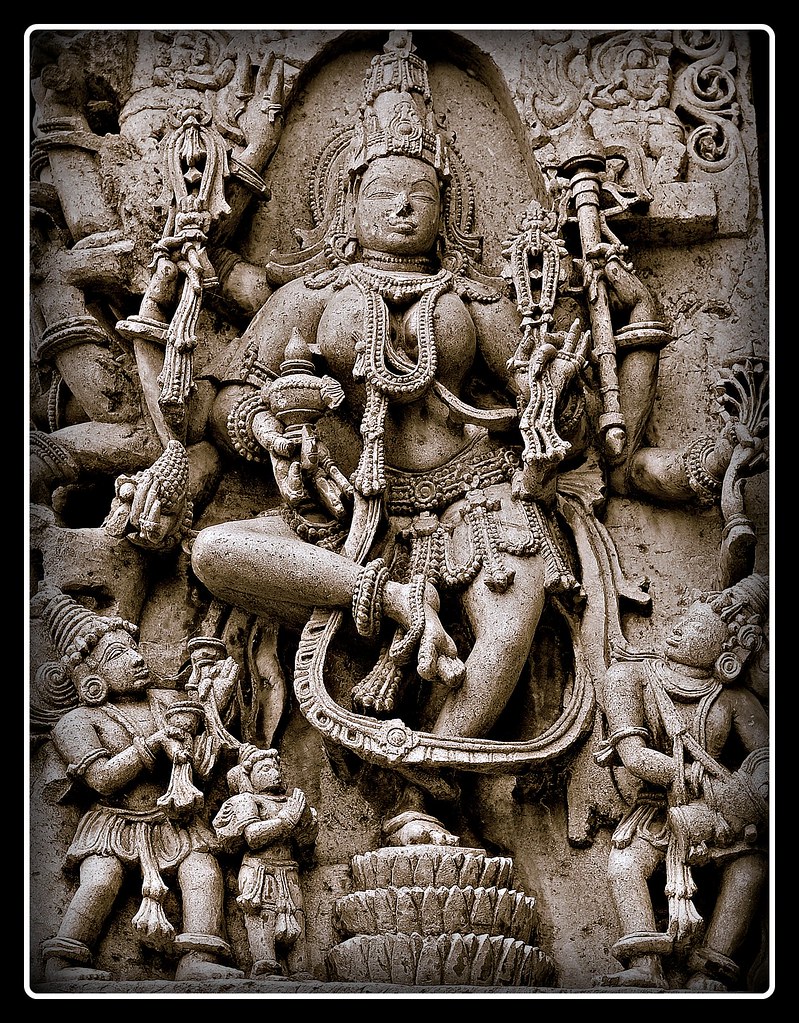
The Hoysaleshwara Temple remains the only surviving monument in Halebidu.
Location
Halebidu is connected by road and rail to Hassan (30 km), Mysore (150 km) and Mangalore (184 km). It is about 15 kilometers from Belur, another site known for its intricately carved Hoysala era temples.

Halebidu is in the midst of a valley east of the Western Ghats. It is surrounded by low-lying mountains, boulders and seasonal rivers.
Hoysaleswara temple, also referred simply as the Halebidu temple, is a 12th-century Hindu temple dedicated to Shiva. It is the largest monument in Halebidu – the former capital of the Hoysala Empire.
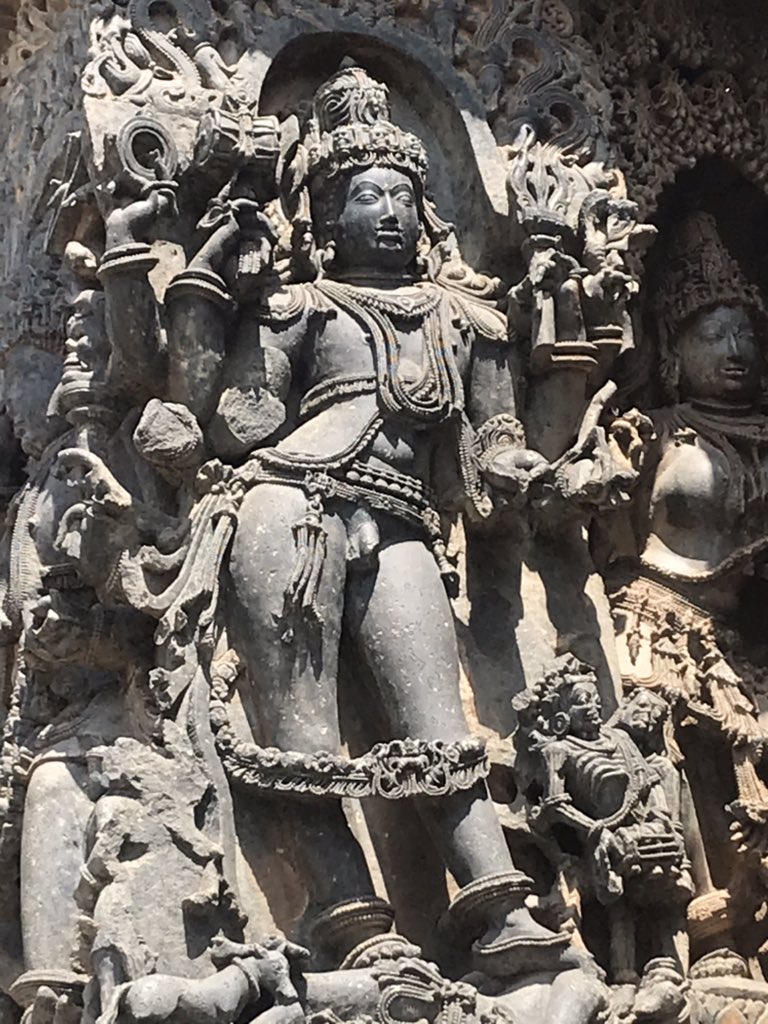
A Few YouTube Videos of Halebidu Hoysala Temple
The temple was built on the banks of a large man-made lake, and sponsored by King Vishnuvardhana of the Hoysala Empire.
Its construction started around 1121 CE and was complete in 1160 CE.
During the early 14th century, Halebidu was twice sacked and plundered by the Muslim armies of the Delhi Sultanate from northern India, and the temple and the capital fell into a state of ruin and neglect. It is about 210 kilometres from Bengaluru.
The Hoysaleswara temple is a Shaivism tradition monument, yet reverentially includes many themes from Vaishnavism and Shaktism tradition of Hinduism, as well as images from Jainism.
The Hoysaleswara temple is a twin-temple dedicated to Hoysaleswara and Santaleswara Shiva Lingas, named after the masculine and feminine aspects, both equal and joined at their transept.

It has two Nandi shrines outside, where each seated Nandi faces the respective Shiva Linga inside.
The temple includes a smaller Sanctum for the Hindu Sun god Surya. It once had superstructure towers, but no longer and the temple looks flat.
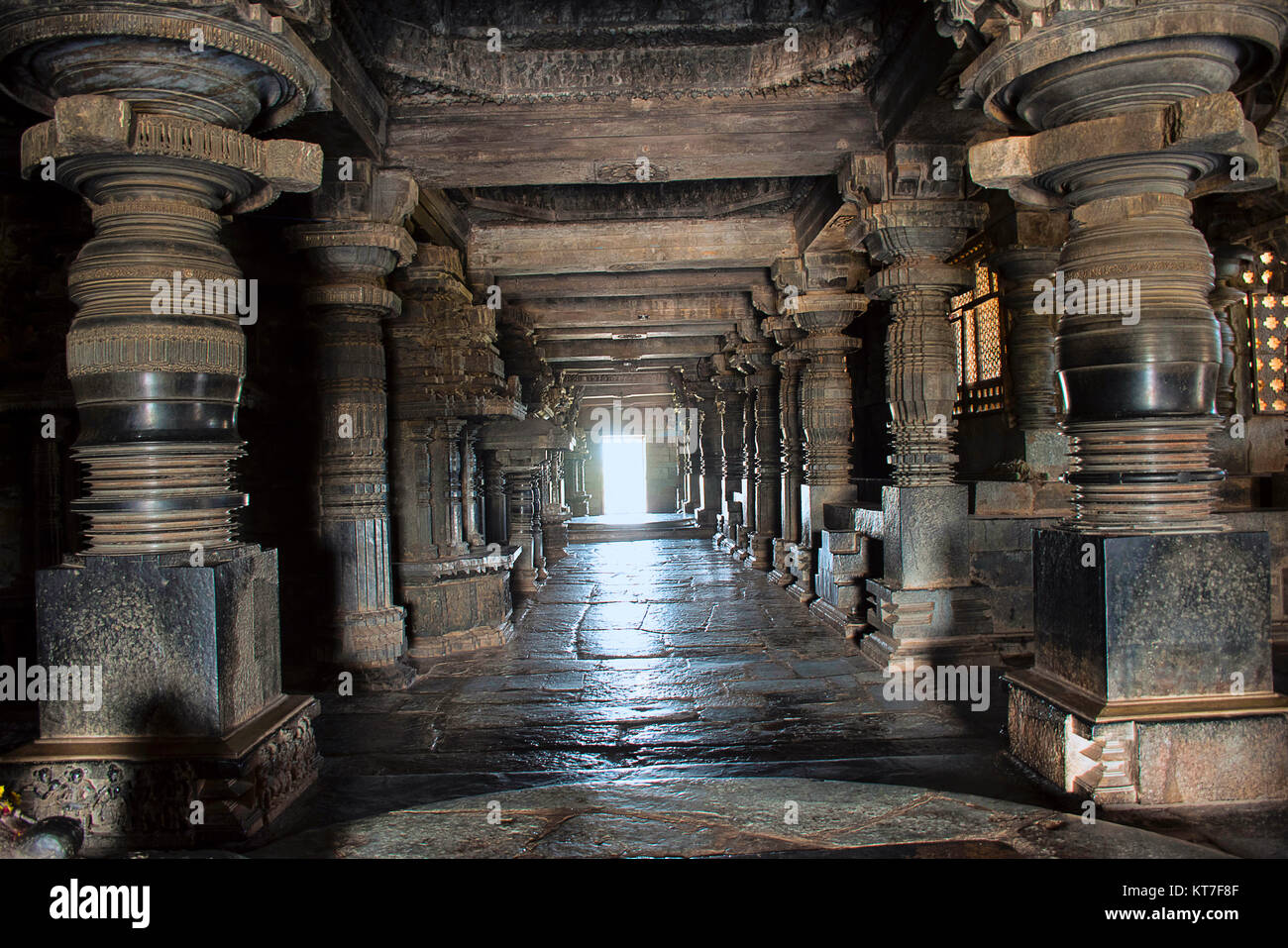
The temple faces east, though the monument is presently visited from the north side. Both the main temples and the Nandi shrines are based on a square plan.
The temple was carved from soapstone. It is notable for its sculptures, intricate reliefs, detailed friezes as well its history, iconography, inscriptions in North Indian and South Indian scripts.
A Few YouTube Videos of Halebidu Hoysala Temple
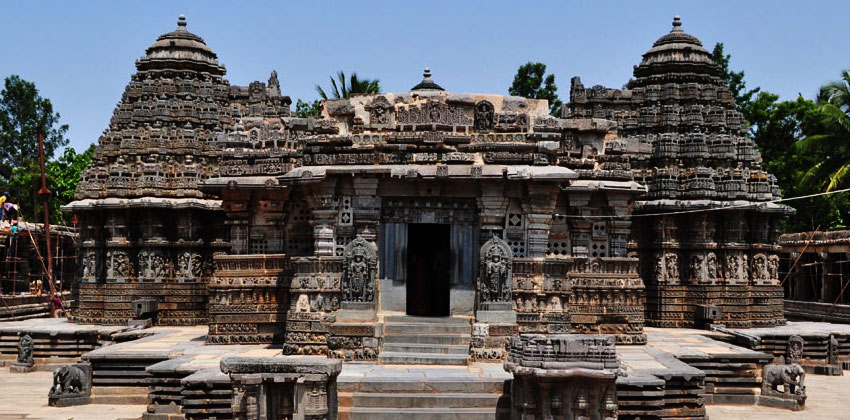
The temple artwork provides a pictorial window into the life and culture in the 12th century South India.
About 340 large reliefs depict the Hindu theology and associated legends. Numerous smaller friezes narrate Hindu texts such as the Ramayana, the Mahabharata and the Bhagavata Purana.

A Few YouTube Videos of Halebidu Hoysala Temple
The artwork in Hoysaleswara temple is damaged but largely intact. Within a few kilometers of the temple are numerous ruins of Hoysala architecture.
The temple, along with the nearby Jain Temples and the Kedareshwara temple as well as the Kesava temple in Belur, have been proposed to be listed under UNESCO World Heritage Sites.
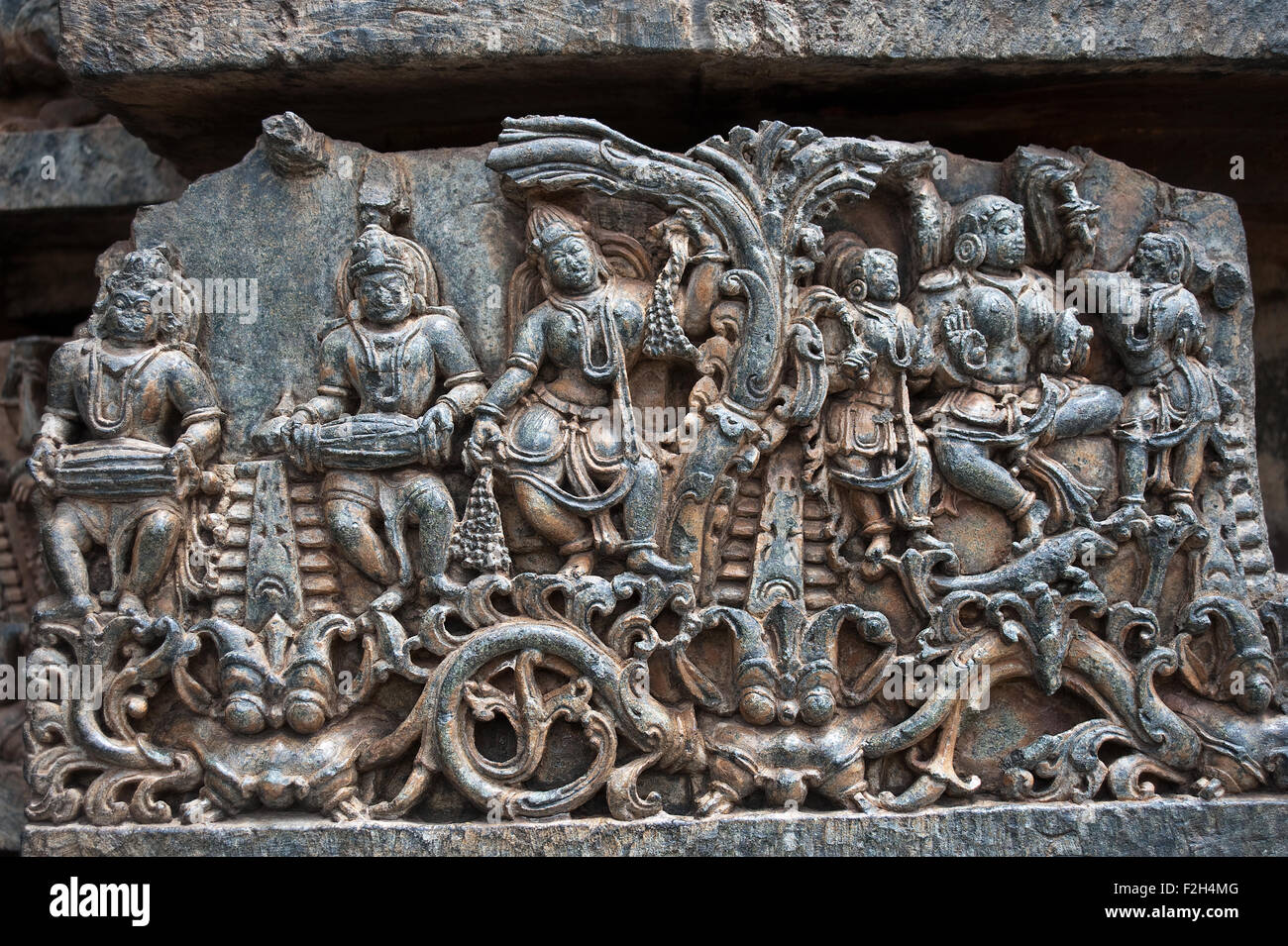
Halebidu has no nearby airport, and is about 210 kilometres west of Bengaluru, about 4 hours drive.
Description of the temple
The Hoysaleswara temple, also spelled as Hoysaleshwara or Hoywalesvara temple, is a twin-temple, or Dvikuta Vimana – plan with two shrines and two superstructures).

The two temples are of the same size, and their Sanctums open to the east, facing sunrise.
The Sanctum of the ‘Hoysaleswara’ (the king) and the other for ‘Shantaleswara’ (the queen, Shantala Devi) both have a Shiva linga.
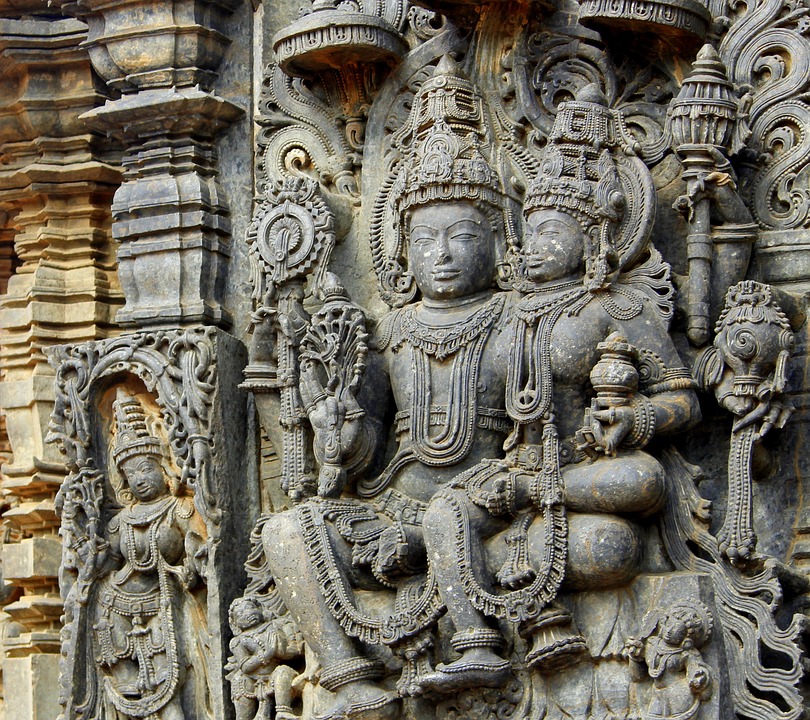
Outside on the east side of the main temples are two smaller shrines, each with seated Nandi. To the east of the southern Nandi shrine is a smaller attached Surya shrine, where there is a 7 feet tall Surya statue facing the Nandi and the Sanctum.

The temple complex as a whole is placed on a Jagati which literally means worldly platform. The smaller shrines share the same Jagati as the main temple, connected by stone stairs.
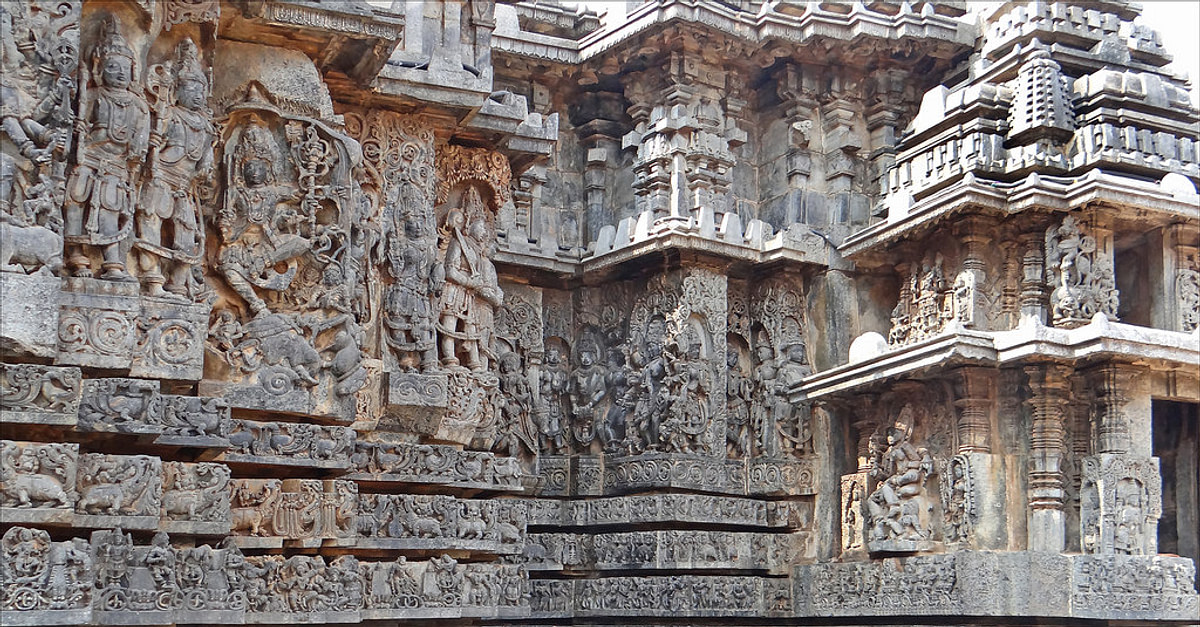
The two Sanctums are next to each other in a north–south alignment, both face east, and each have in front a Mandapa.
The two Mandapas are connected giving a view of a large, open Navaranga for family and public gatherings.
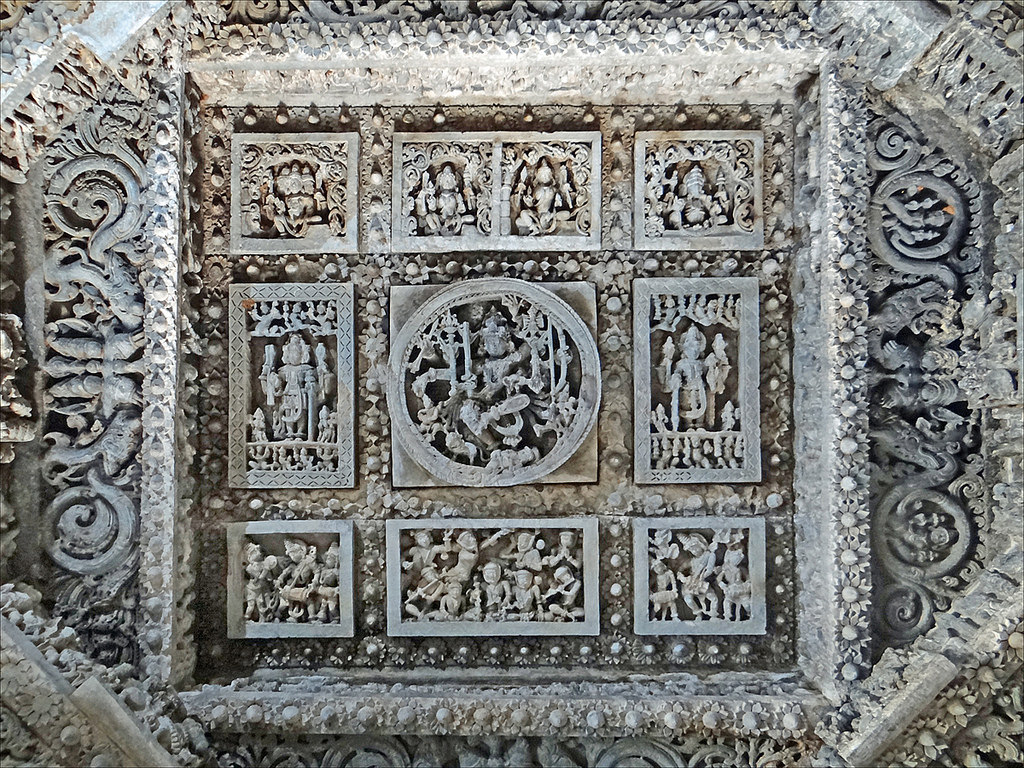
The temple had towers on top of each Sanctum, but they are now missing.
The temple was built with soapstone. The soapstone is soft when quarried and easier to carve into intricate shapes, but hardens over time when exposed to air.
Outer walls
The temple outer walls is intricately carved. Its lowest layers consist of bands with friezes that consist of (from bottom to top) elephants, lions, scrolls with nature and miniature dancers, horses, scrolls, scenes from Hindu texts, mythical beasts (Makara) and swans.
A Few YouTube Videos of Halebidu Hoysala Temple
No two lions are alike in the entire span that covers more than a furlong (200 metres.
The artists have captured the Ramayana and the Mahabharata, and the main episodes of the Bhagavata.
The temple’s outer wall is a pictorial narration of Hindu epics, and its middle portion has large panels where the entire pantheon of Hindu divinities are presented, it is a manual of Hindu iconography.
The quality and quantity of the epics-related friezes are amazing, but the panel series do not complete the story in a stretch, rather after a stretch, another text is intermingled in for a while.
The outer walls of the Hoysaleswara temple shrines feature 340 large reliefs.
The walls on the other side have more large images.
Doorways & Mandapas
The temple has four entrances. The one normally used by visitors as main entry nowadays is the northern entrance closest to the parking lot. There is one entry on the south side and two on the east side, facing two large detached open pavilions whose ceiling is supported by lathe turned pillars.
The temple originally had an open Navaranga, wherein the Mantapa pavilions were visible from outside shrines and the outside was visible to those in the mandapa.
In the era of Hoysala king Narasimha I, the Mantapa was closed, doors were added and perforated stone screens placed. Along with the four doors, the later artists added dvarapalas and decorations too.
Outside the southern doorway, in the park, are large statues, one of Ganesha. The statue was among those which were originally farther out at the temple premises outer gate, but damaged and collected from ruins there.
They were recovered and placed close to the temple. The Navaranga includes two small niches facing each other between the two temples where they are joined at the transept.
These have carvings and artwork, but the statues inside each is missing. There is a stone panel near the western niche with a large Sanskrit inscription in a North Indian and a South Indian script.
Pillars & ceilings
The interior walls of the temple are quite plain compared to the outer wall, except for the lathe turned pillars that run in rows between the north and south entrances.
The four pillars in front of each shrine are the most ornate and the only ones that have the Madanika sculptures in their pillar brackets.
The fused mandapa features a row of pillars aligned along the north-west axis. In the central navaranga of each temple’s mandapa are four pillars and a raised ceiling that is intricately carved.
Each of the four pillars of this central navaranga had four standing Madanakai figures, or a total of 16 standing figures per temple.
Of the 32 figures on the central pillars for the two temples, 11 remain. Only 6 damaged ones have survived in the north temple and 5 in the south temple.
A closer examination of the pillar’s capital suggests that there was a figure on each pillar in the eastern row facing the sunrise, but all of these show signs of destruction and none of those images have survived.
The pillar near the second eastern door have two damaged Madanakai, but the better preserved are those in the central Navaranga.
Sanctum Sanctorum
The twin-temple has two Sanctums (Garbha Griha), both with Shiva linga. One Sanctum is dedicated to ‘Hoysaleswara’ Shiva (the king) and the other for ‘Shantaleswara’ Shiva (the queen, Shantala).
Both are of equal size. Each sanctum is a square with a Darsana Dvara (view doorway) on the east, with three niches on the north, west and south.
There is intricate carving above the lintel between the Dvarapalas, presenting Shiva with Parvati, along with other Devas and Devis, as well as two large Makaras (mythical syncretic sea creatures).
On the Makaras are Varuna and his wife Varuni riding. The doorjambs are decorated with Purnaghatas (vessels of abundance).
The sanctum walls are plain, avoiding distraction to the devotee and focussing the attention of the visitor at the spiritual symbol.
The temple has smaller shrines with its own sanctum. For example, the Nandi shrines feature a Nandi in its sanctum, while the Surya shrine features the Hindu Sun god.
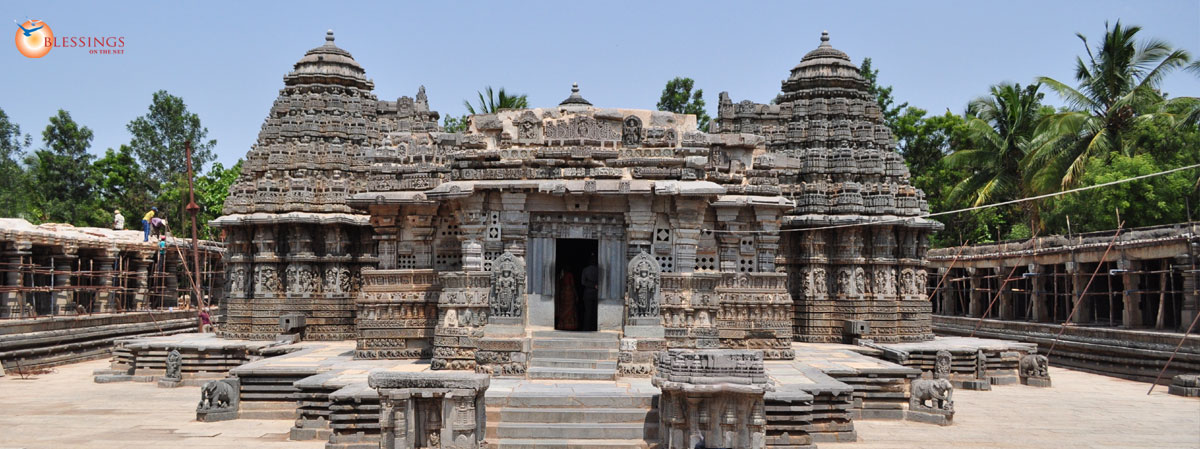
One reply on “The Marvels of Karnataka: Halebidu Hoysaleswara Temple, An Amazing Example of Hoysala Architecture”
Hi Ms.Mala,
Nice to read through your blog. You have shared many interesting facts in this.
However, wanted to share one observation : the picture (the very first pic) that you have posted with a note that its halebedu seems to be that of somanathapura. May be you can fact check on that and do the modifications if required. Hope you d0ont mind me sharing this.
Thank you
LRK
If you find time, you may view my channel for covering some rare temples as well :https://www.youtube.com/channel/UCNZ_mJXCF10lfLq4WgSLfLQ